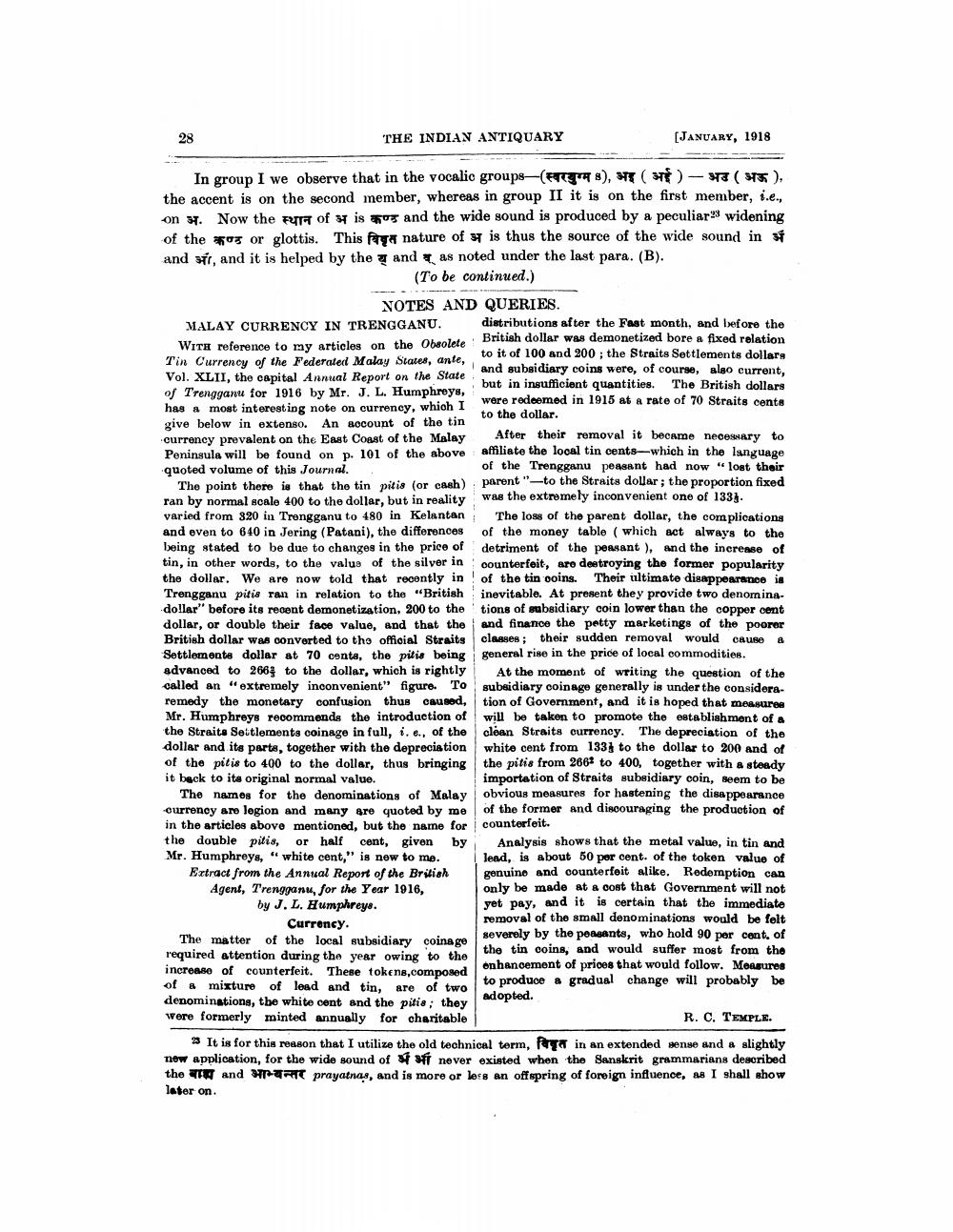________________
THE INDIAN ANTIQUARY
(JANUARY, 1918
In group I we observe that in the vocalio groups-( s), 9 ( ) - 97 (575), the accent is on the second member, whereas in group II it is on the first member, i.e., on s. Now the First of is us and the wide sound is produced by a peculiar widening of the oy or glottis. This fra nature of is thus the source of the wide sound in and i, and it is helped by the 7 and as noted under the last para. (B).
(To be continued.)
NOTES AND QUERIES. MALAY CURRENCY IN TRENGGANU. distributions after the Fast month, and before the
British dollar was demonetized bore a fixed relation WITH reference to my articles on the Obsolete!
to it of 100 and 200 ; the Straits Settlements dollar, Tin Currency of the Federated Malay States, ante,
and subsidiary coins were, of course, algo current, Vol. XLII, the capital Annual Report on the State
but in insufficient quantities. The British dollars of Trengganu for 1916 by Mr. J. L. Humphreys,
were redeemed in 1915 at a rate of 70 Straits cente has a most interesting note on currency, which I
to the dollar. give below in extenso. An account of the tin currency prevalent on the East Coast of the Malay After their removal it became necessary to Peninsula will be found on p. 101 of the above affiliate the local tin cents—which in the language quoted volume of this Journal.
of the Trengganu peasant had now "lost their The point there is that the tin pitis (or cash) parent"-to the Straits dollar; the proportion fixed ran by normal scalo 400 to the dollar, but in reality was the extremely inconvenient one of 133). varied from 320 in Trengganu to 480 in Kelantan The loss of the parent dollar, the complications and even to 640 in Jering (Patani), the differences of the money table (which act always to the being stated to be due to changes in the price of detriment of the peasant ), and the increase of tin, in other words, to the value of the silver in counterfeit, aro destroying the former popularity the dollar. We are now told that recently in of the tin coins. Their ultimate disappearance is Trengganu pitis ran in relation to the “British inevitable. At present they provide two denominadollar" before its recent demonetization, 200 to the 'tions of subsidiary coin lower than the copper cent dollar, or double their face value, and that the and finance the petty marketings of the poorer British dollar was converted to the official Straits classes; their sudden removal would cause & Settlements dollar at 70 cents, the pitis being general rise in the price of local commodities. advanced to 2664 to the dollar, which is rightly At the moment of writing the question of the called an "extremely inconvenient" figure. To subsidiary coinage generally is under the consideraremedy the monetary confusion thus caused, tion of Government, and it is hoped that measures Mr. Humphreys recommends the introduction of will be taken to promote the establishment of a the Straits Settlements coinage in full, i.e., of the clean Straits currency. The depreciation of the dollar and its parts, together with the depreciation white cent from 1333 to the dollar to 200 and of of the pitis to 400 to the dollar, thus bringing the pitis from 2661 to 400, together with a steady it back to its original normal value.
importation of Straits subsidiary coin, seem to be The names for the denominations of Malay obvious measures for hastening the disappearance currency are legion and many gre quoted by me of the former and discouraging the production of in the articles above mentioned, but the name for counterfeit. the double pitis, or half cent, given by Analysis shows that the metal value, in tin and Mr. Humphreys, "white cent," is now to me. lead, is about 50 per cent. of the token value of Extract from the Annual Report of the British genuine and counterfeit alike. Redemption can Agent, Trengganu, for the Year 1916,
only be made at a cost that Government will not by J.L. Humphreys.
yet pay, and it is certain that the immediata Currency.
removal of the small denominations would be felt The matter of the local subsidiary coinage
severely by the peasants, who hold 90 per cent of required attention during the year owing to the
the tin coins, and would suffer most from the increase of counterfeit. These tokens,composed
onhancement of prices that would follow. Measures of a mixture of lead and tin, are of two
to produce a gradual change will probably be denominations, the white cent and the pitie; they
adopted. were formerly minted annually for charitable
R. C. TEMPLE. It is for this reason that I utilize the old technical term, fry in an extended sense and a slightly new application, for the wide sound of aff never existed when the Sanskrit grammarians described the and T F prayatnas, and is more or less an offspring of foreign influence, as I shall show later on.




